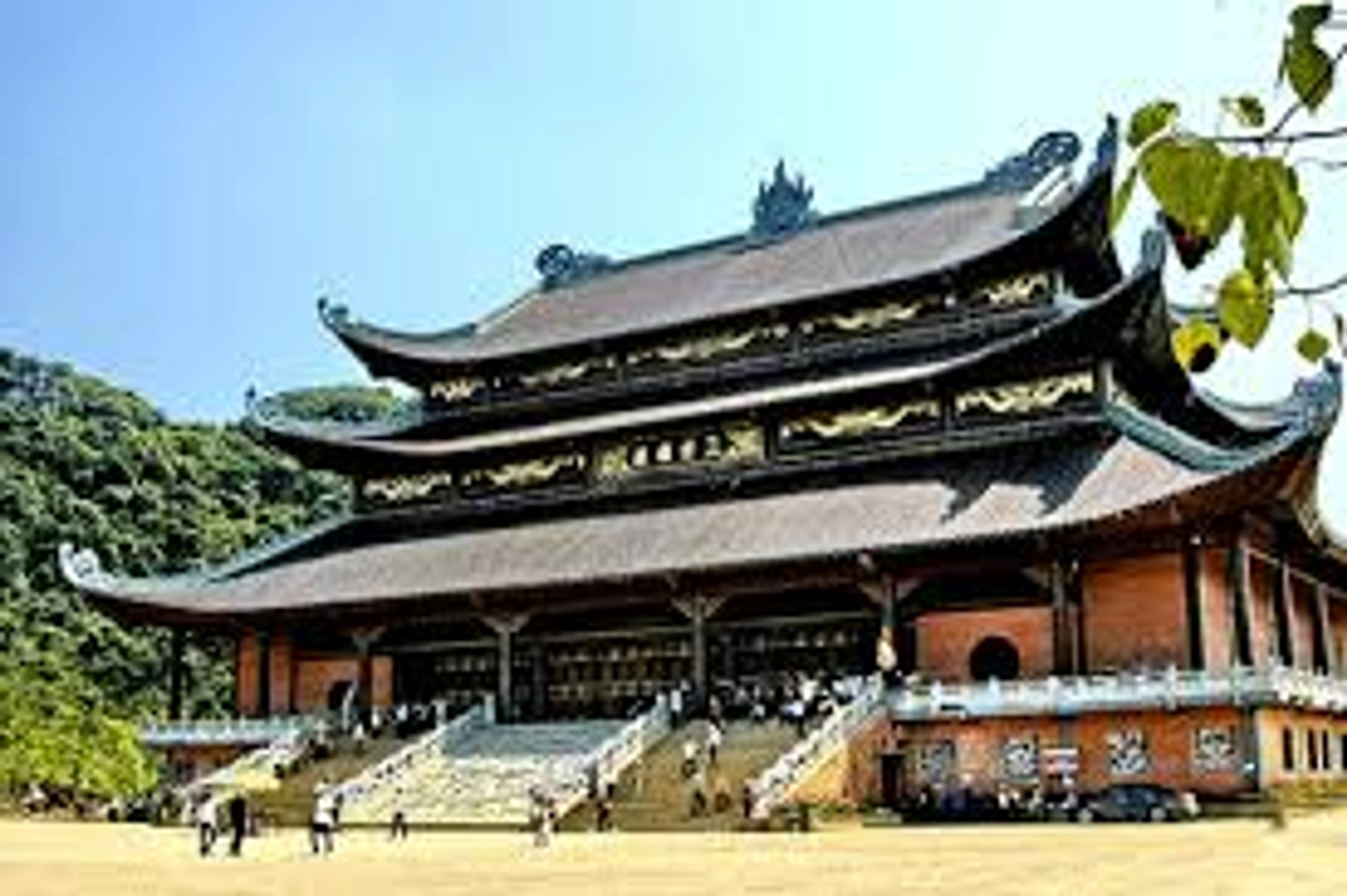

Bai Dinh Temple is not only a symbol of Vietnamese spirit and culture, but it has also witnessed the rise and fall of many dynasties from the Dinh and Early Le to the Ly dynasties. Discover the secrets and travel experiences at this top spiritual site in Ninh Binh through the detailed article on BDATrip.
Located in Northern Vietnam and renowned for the majestic beauty of Ninh Binh's mountains, Bai Dinh Temple is not only an ecological and spiritual destination but also a profound cultural heritage. This temple has a long history of development, evolving from a small temple to a massive Buddhist architectural complex.
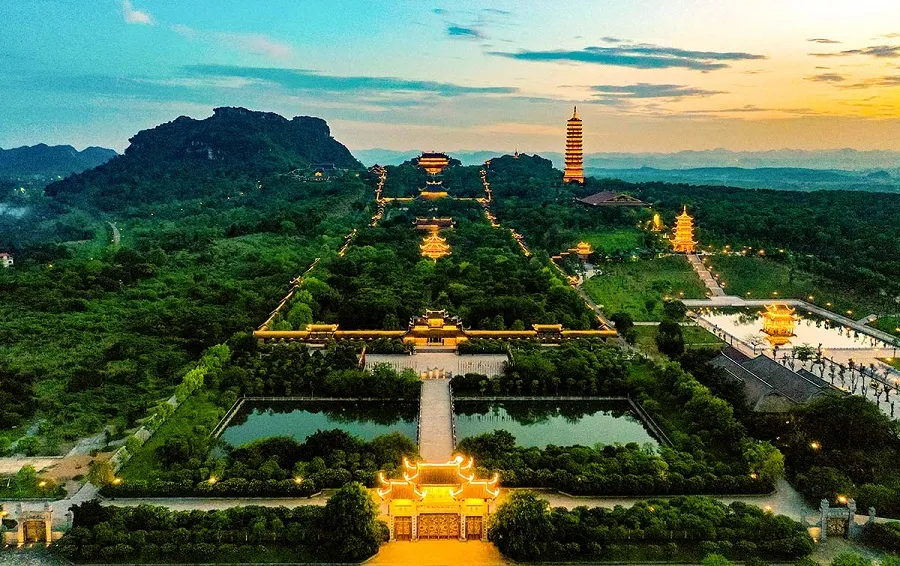
The history of Bai Dinh Temple dates back to the Ly dynasty when it was just a small temple. Over the centuries, especially in recent years, the temple has been expanded and renovated on a grand scale to meet the spiritual needs and sentiments of modern people. This development has not only helped preserve cultural values but also promoted spiritual tourism in the area.
Bai Dinh Temple has also set several records in both Vietnam and Asia, such as the largest bronze bell in Vietnam, the tallest and heaviest statue of Buddha Sakyamuni in Asia, the largest gold-inlaid bronze Tam The statue in Vietnam, the largest bronze Maitreya statue in Southeast Asia, and the longest Arhat corridor in Vietnam. Additionally, the temple holds the most Bodhi trees in Vietnam, creating a serene and sacred space.
Located on Bai Dinh Mountain in Gia Sinh commune, Gia Vien district, Bai Dinh Temple is a distinctive religious complex just 5km northwest of the ancient capital of Hoa Lu and about 12km from the city of Ninh Binh. With a total area of 539 hectares, of which the old temple area occupies 27 hectares and the new area covers 80 hectares, Bai Dinh Temple has long been a sacred pilgrimage site, attracting thousands of Buddhists annually.
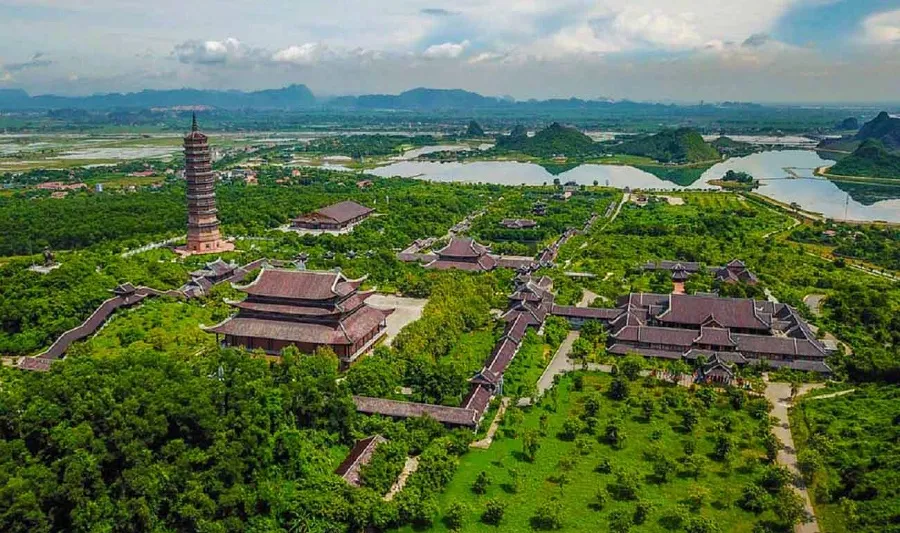
The ideal time to visit Bai Dinh and Trang An is from January to March in the lunar calendar when the spring weather is warm. This period not only offers the chance to enjoy the spring scenery but also to participate in rituals for good fortune at the famous temples, as well as partake in large festivals held at both locations. However, as this is the peak season for festival tourism, the area can become overcrowded and busy. Therefore, if you prefer peace and quiet, consider visiting at a different time of the year.
With its vast premises, Bai Dinh Temple offers an electric car service for the convenience of visitors. If you are pressed for time, using an electric car is a practical option. The cost for each ride is 30,000 VND.
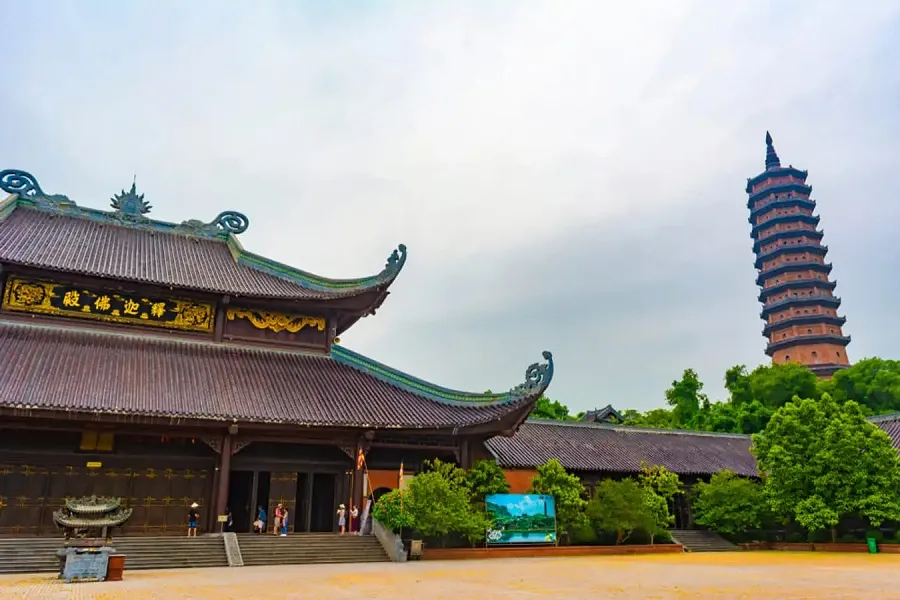
To experience the beauty of the Trang An scenic spot, you will embark on a journey of over three hours by boat. Each boat can accommodate between 4 and 5 people, with tickets priced at 150,000 VND per person. During peak season, the influx of tourists visiting Trang An can lead to overcrowding at ticket sales points, entrance controls, and boat docks. Therefore, to ensure personal safety, you might consider choosing organized Bai Dinh tours, and always be vigilant to protect your belongings and stay alert to the risk of theft and pickpocketing.
Upon ascending the 300 stone steps to the main gate, take a moment to look at the fork next to the slope. Here, two paths will lead you to the Bright Cave and the Dark Cave. The Bright Cave, a place of worship for Gods and Buddha, is naturally lit, offering a spacious and tranquil environment. At the entrance, statues of two majestic gods with stern expressions welcome pilgrims. Inside, the cave extends about 25 meters deep, 15 meters wide, and over 2 meters high, housing revered Buddha statues. At the end of the cave is the entrance to the temple of the sacred Cao Son deity.

Although the Dark Cave lacks natural light, it is equipped with a lighting system that creates a mysterious and surreal atmosphere. The cave walls, formed by underground water channels, reflect light, adding to its enchanting beauty. The path inside the cave is decorated with dynamic dragon sculptures, adding an element of mystery and intrigue. In the center of the cave, a natural well helps to regulate the air, bringing a cool and purified feeling to visitors. In this cave, statues of deities and fairies are cleverly placed in rocky niches, each with its own altar, drawing reverence from visitors.
At the fork leading up to the main gate of Bai Dinh Temple, a path leads to the shrine dedicated to Zen Master Nguyen Minh Khong, a saint who made significant historical contributions to this land. The shrine is situated within the Bai Dinh Temple complex and is built in a style that leans against the mountain and faces the river, creating a sacred and peaceful space.
Inside the shrine, there is a statue of Zen Master Nguyen Minh Khong, who was not only a renowned physician but also a skilled bronze caster. According to legend, during a trip to find medicinal herbs for the king, he discovered a beautiful cave and decided to build a temple there to worship Buddha. He is also known for his research on the Dong Son civilization and his efforts to revive the traditional bronze casting craft of Vietnam.

The shrine is designed in a "front-first, back-cong" style, with an expansive front and a rear in the shape of the Cong character, creating a solid and harmonious overall architecture. The shrine's interior is intricately detailed with lively carvings of flowers, dragons, and mythical creatures, each architectural element reflecting the skill and finesse of traditional Vietnamese sculpture.
To commemorate and honor the virtues of Zen Master Nguyen Minh Khong, the locals not only erected his statue in Bai Dinh Temple but also worship him in many places across Ninh Binh Province, symbolizing their respect and his profound influence on the spiritual and cultural life of the local community.
Legend has it that Zen Master Nguyen Minh Khong once used water from an ancient well here to prepare medicines for the king and local people. Ngoc Well, situated solemnly in the middle of Bai Dinh Temple's courtyard, is surrounded by skillfully carved stone railings forming a large circular shape. From the high position of the main hall, looking down, Ngoc Well appears impressive with its emerald-green water, creating a special highlight in the verdant surroundings of the courtyard.
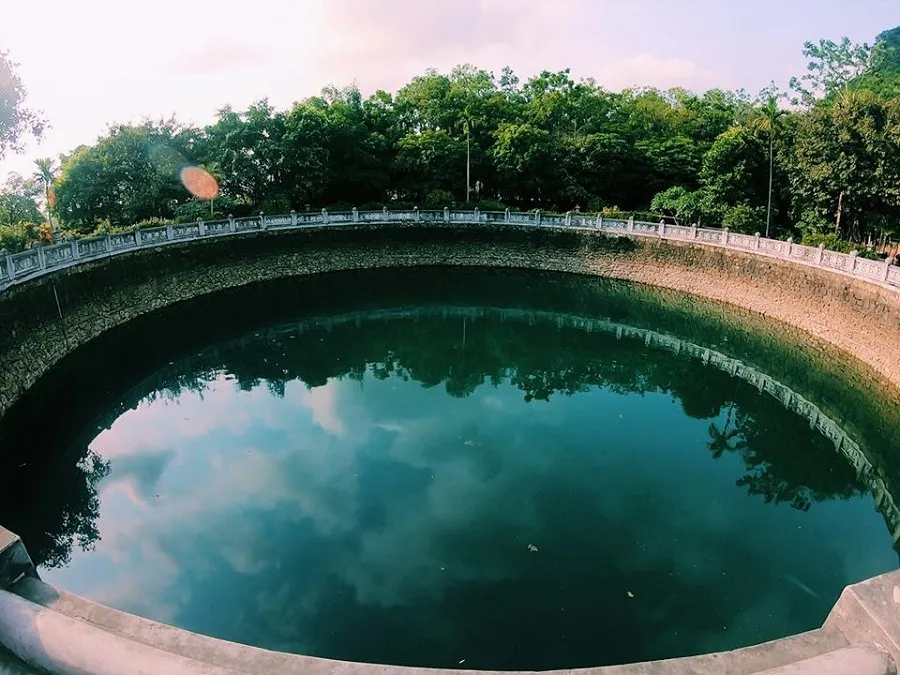
Not only famous for its location and beauty, Ngoc Well is also known as the largest temple well in Vietnam, recognized as a national record. This distinctive feature further emphasizes the historical and spiritual value of Bai Dinh Temple, attracting thousands of pilgrims and Buddhist followers each year.
The new Bai Dinh Temple is not only a spiritual destination but also stands out with its large and unique constructions in Southeast Asia. Among them, the largest bronze bell in Vietnam is a remarkable artistic work, standing 5.5 meters tall, 3.5 meters in diameter, and weighing up to 36 tons. The bell is exquisitely engraved with ancient Chinese characters and vibrant dragon motifs, demonstrating the skill and depth of the art of bronze casting.
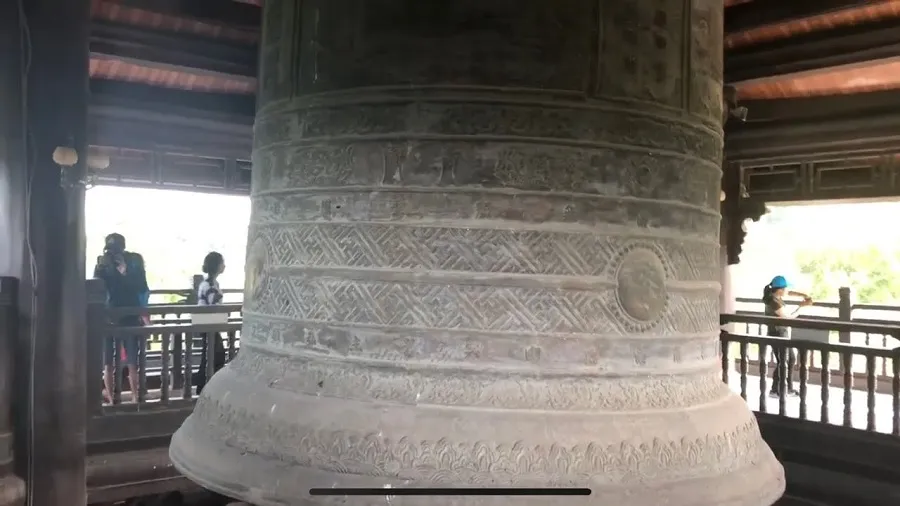
The largest Buddha Sakyamuni statue in Asia, the centerpiece of the Dharma Master at Bai Dinh Temple, is another impressive construction, weighing 100 tons and standing 9.5 meters tall. Standing before this statue, one cannot help but be overwhelmed by its beauty and majestic splendor, offering a profound sense of awe and sanctity.
When visiting Bai Dinh Temple, it's important to choose appropriate clothing and footwear to ensure comfort throughout the journey. Athletic shoes are an ideal choice, as you may need to climb mountains and move around a lot. Avoid high heels or flat shoes to protect your feet and provide better support during movement. Regarding clothing, wear polite and comfortable attire, opting for outfits that are not too tight and have good sweat-absorption properties.
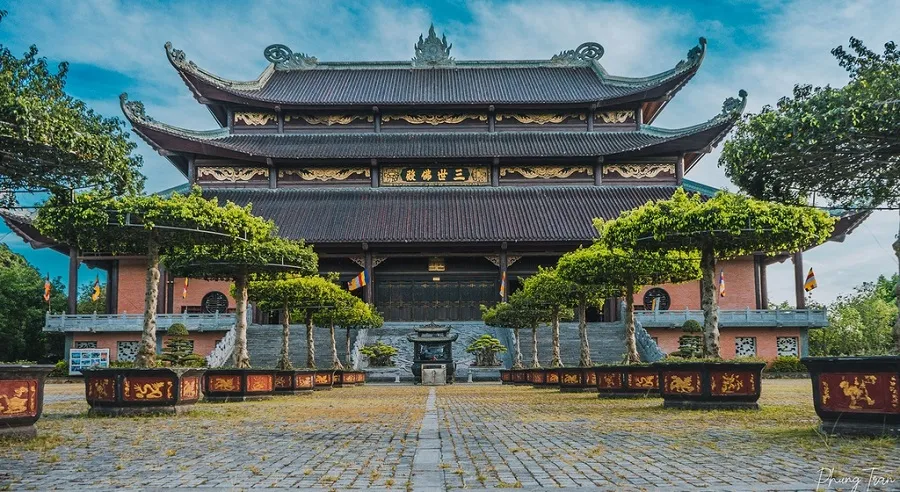
While visiting, you will find many stalls selling souvenirs and local specialties. However, prices at these locations are generally higher than outside. If you plan to buy gifts, consider shopping at the foot of the mountain, where prices are usually more affordable.
Springtime here may bring light drizzle, so it's advisable to carry a small foldable umbrella in case of rain.
When participating in temple rituals and making donations, remember to bring small change. Instead of placing money on the Buddha statues, which can detract from the temple's aesthetic, place your donations in the designated donation boxes prepared in advance.
We hope this information will help make your trip to Bai Dinh Temple truly enriching and memorable.
Some attractive tourist attractions in Ninh Binh:
Copyright © 2022 BDATrip.com | All rights reserved.